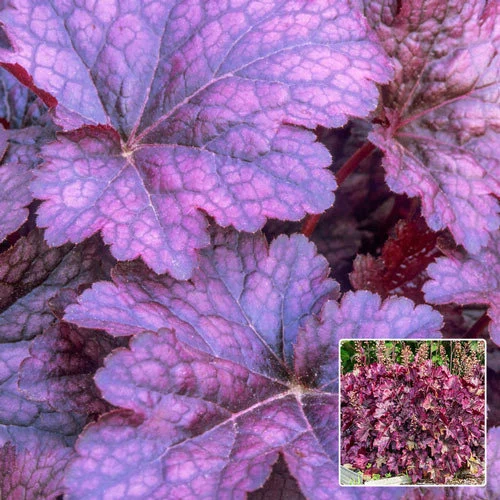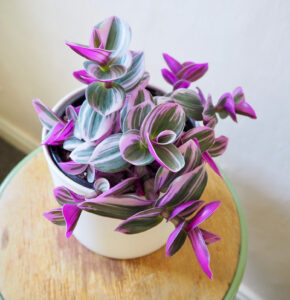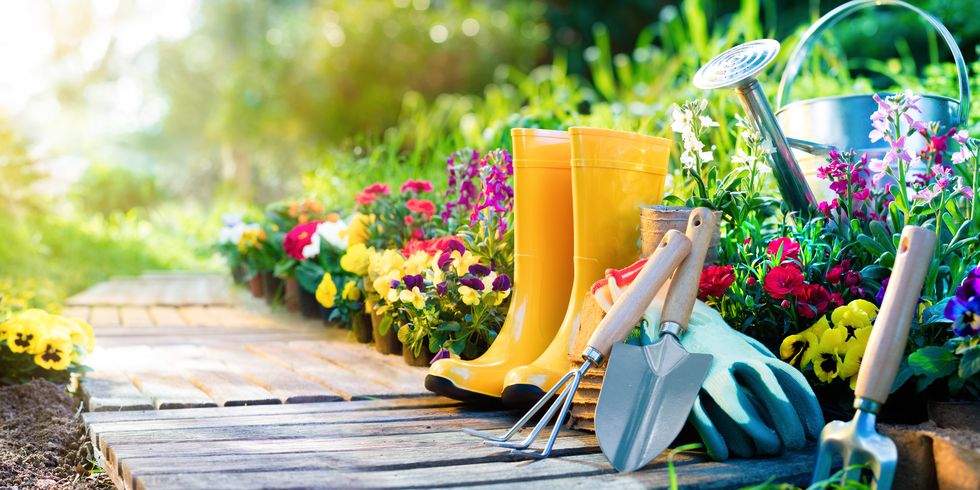The Palace Purple Heuchera (Heuchera micrantha ‘Palace Purple’) is a stunning perennial plant known for its striking burgundy-purple foliage and its ability to add vibrant color to both shaded and sunny gardens. It’s a popular variety of Heuchera, also known as Coral Bells, and is particularly appreciated for its toughness, low maintenance, and ability to thrive in a range of conditions.
Here’s a detailed care guide to help you grow a healthy and beautiful Palace Purple Heuchera:
1. Light Requirements
- Partial to Full Shade: The Palace Purple Heuchera does best in partial shade to full shade, although it can tolerate some morning sun. In sunnier areas, it’s important to provide some afternoon shade to prevent the leaves from scorching. Direct, harsh sunlight can cause the deep purple leaves to fade, so it’s best to place it in a location where it receives dappled light or shaded conditions.
- Tolerates Full Sun in Cooler Climates: If you’re in a cooler climate with lower temperatures, Palace Purple Heuchera can tolerate full sun, but make sure the plant gets enough moisture and shade during the hottest part of the day.
2. Soil Requirements
- Well-Draining Soil: Heucheras prefer well-draining soil that is rich in organic matter. The soil should be slightly acidic to neutral (pH 5.5 to 7.0). Loamy or sandy soil works well as long as it doesn’t retain too much water, which can lead to root rot.
- Soil Preparation: To improve soil structure, you can mix in some compost or organic matter before planting, which will enhance the drainage and provide additional nutrients for healthy growth.
3. Watering
- Consistent Moisture: Heucheras, including the Palace Purple variety, prefer consistent moisture but do not like to be waterlogged. Water the plant regularly, especially during dry spells, but be sure the soil is allowed to dry out slightly between waterings.
- Watering Tips: The plant does well when watered deeply, allowing the water to reach the root zone. Watering in the early morning is ideal, as this gives the plant time to dry before evening and helps prevent fungal diseases.
- Signs of Over-Watering: If the leaves turn yellow or become mushy, it may be a sign of over-watering. Ensure that the plant is in a well-drained area, and avoid letting water sit around the base of the plant.
4. Temperature and Hardiness
- Cold-Hardy: The Palace Purple Heuchera is hardy in USDA zones 4-9, making it suitable for a wide range of climates. It can tolerate frost, and its colorful foliage persists through cooler months, adding interest to the winter garden.
- Avoid Extreme Heat: In very hot climates, Heucheras may struggle with the heat, so providing them with some afternoon shade and adequate water can help them stay healthy during summer heatwaves.
5. Fertilizing
- Low-Maintenance Fertilization: Heucheras generally do not need a lot of fertilizing, but feeding can promote more vibrant foliage. Use a balanced, slow-release fertilizer in early spring as the plant begins to grow. A general-purpose fertilizer is suitable for Palace Purple Heuchera.
- Organic Matter: You can also amend the soil with compost or well-rotted manure to provide the plant with nutrients. Be sure not to over-fertilize, as excessive feeding can lead to leggy growth and diminished foliage color.
6. Pruning and Maintenance
- Deadheading and Removal of Old Leaves: To keep your Palace Purple Heuchera looking neat and tidy, remove any dead or damaged leaves regularly. If the plant gets too leggy or unkempt, you can cut back the old foliage in early spring to encourage fresh, vibrant growth.
- Cutting Back: You can cut back the plant’s leaves near the base during the growing season if they become unattractive. This can also help promote new growth, especially after flowering. However, leave the foliage intact over winter, as it can help protect the crown of the plant.
7. Propagation
- Division: One of the easiest ways to propagate Palace Purple Heuchera is by dividing the plant. In early spring or fall, carefully dig up the plant and divide the root ball into smaller sections, each with a portion of the root system. Replant the divisions in well-drained soil, and make sure the crowns are level with the soil surface.
- Stem Cuttings: You can also propagate Heuchera by taking stem cuttings, though it is more commonly done through division.
8. Pests and Problems
- Pests: Heucheras are relatively pest-resistant, but they can occasionally attract aphids, mealybugs, or slugs. These pests can be controlled using insecticidal soap or neem oil. Slugs and snails can be deterred by using organic slug pellets or creating a physical barrier around the plant.
- Diseases: Heucheras are susceptible to powdery mildew and rust if conditions are too humid or if the plant is overcrowded. To prevent these diseases, ensure proper air circulation, avoid overhead watering, and remove any affected leaves. If powdery mildew occurs, treating the plant with fungicide or a mixture of water and baking soda can help control the problem.
9. Companion Plants
- Shade Garden Companions: The Palace Purple Heuchera pairs beautifully with other shade-loving perennials, such as hostas, astilbes, brunnera, ferns, and lamium. It also works well with flowering plants like bleeding heart (Dicentra) or columbine (Aquilegia), which will complement its colorful foliage.
- Contrasting Colors: The deep purple tones of Palace Purple Heuchera contrast nicely with bright green, yellow, or silver-leaved plants, creating a stunning visual effect in the garden.
10. Toxicity
Like most Heucheras, the Palace Purple Heuchera is considered non-toxic to pets, making it a safe choice for gardens where animals roam. However, as a precaution, it’s always good to discourage pets from nibbling on any plants.
11. Benefits of Palace Purple Heuchera
- Aesthetic Appeal: The rich, dark purple foliage of the Palace Purple Heuchera provides dramatic color and texture in the garden, especially in shady spots. Its colorful leaves create a striking contrast with other plants and brighten up dark corners of the garden.
- Year-Round Interest: The foliage remains attractive through much of the year, and the small, bell-shaped flowers that emerge in late spring to early summer add a delicate touch of beauty, typically in shades of pink or white.
- Low Maintenance: Heucheras are low-maintenance plants that require minimal care, making them an excellent choice for both novice and experienced gardeners.
Conclusion
The Palace Purple Heuchera is a beautiful, hardy perennial that adds rich color and texture to your garden or landscape. It thrives in partial to full shade, with minimal care required to keep it healthy and attractive. By providing it with the right soil, moisture, and occasional maintenance, you can enjoy its stunning foliage and delicate flowers for many seasons. Whether used as a groundcover, border plant, or in containers, the Palace Purple Heuchera is a fantastic addition to any garden.
Proudly powered by WordPress






